|
|
History of Burntisland's Cinemas
Site navigation - please use menu on left (click here to display it if not visible). If problems, use site map.
|
History of Burntisland's Cinemas Site navigation - please use menu on left (click here to display it if not visible). If problems, use site map. |
The Palace, The Porte and The Picture House
by
Norman Mackie
[Sadly, Norman died on 14 June 2008, aged 95.]
|
The Palace |
Silent
pictures were first shown in Burntisland early in the first world war
at the Palace on the corner of the Kirkgate and East Leven Street. The
Palace started life as a Church. This, after the Reverend David Couper
and some of the congregation broke in 1843 with the Church of Scotland
and, somewhat provocatively, built a rival church opposite the parish
church.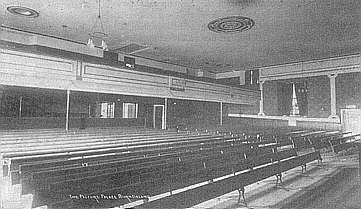 In 1860 they built a second
church, St Andrew's (also known as the Couper Church) in the High
Street. The vacated Kirkgate building then became Frank Quarton's grain
store before taking on a new life as the Palace with the introduction
of silent pictures. (The interior of the old Palace cinema is pictured
right.)
In 1860 they built a second
church, St Andrew's (also known as the Couper Church) in the High
Street. The vacated Kirkgate building then became Frank Quarton's grain
store before taking on a new life as the Palace with the introduction
of silent pictures. (The interior of the old Palace cinema is pictured
right.)
Silent pictures on a large screen brought a new form of entertainment to the people of Burntisland. They came to see Douglas Fairbanks Senior and Mary Pickford, Pola Negri, Charlie Chaplin, Buster Keaton, Charley Chase, Our Gang, Harold Lloyd and many others. The sub titles, hard forms and tip-up seats, were accompanied by the music of a resident pianist and augmented on Friday evenings with a violinist and drums. Who can forget the adept musical improvisation of Mrs Fraser for funerals, horse racing and amorous love scenes? What of her ability to pluck a sweet out from her bag at the end of the keyboard without missing a note! Who can still remember singing to the words and following the bouncing ball or following the adventures of Tarzan of the Apes, Miracles of the Jungle, or Pearl White? Other acts also appeared live on stage, these included underwater antics in a large water tank, shooting gallery experts and many escapologists, including the famous Harry Houdini who made an appearance during his last world tour. Matinees were Wednesdays, 4 pm, and Saturdays, 2 pm, admittance to matinees were one old penny and twopence, evening shows were 6 pm and 8 pm. Close by were the sweetie shops, in this case Bisset (Bottler), Mrs Campbell in the Kirkgate, also Lows, High Street - the inevitable late closing on a Saturday evening providing the famous Lows boilings - twopence per quarter.
The buildings adjoining the Palace are also of interest. The first Labour Exchange was in the annex behind Thistle Cottage and later in Leven Villa. Leven Villa was built on the Lammerlaws and then dismantled, stone by stone and completely rebuilt in the Kirkgate to allow the excavation of the Lammerlaws for the many rail tracks required on the East Dock. The house immediately across the street, now number 33, housed the first telephone exchange, and was operated by the Riley family. The Church also built the country school, now the derelict Leven Street Hall, adjacent to the Palace building. The school catered for children from the country and was on top of the steep incline from the foreshore, hence the Scholars' Brae.
In the mid '20s Mr Andrew Maxwell, the manager of the Palace, retired and the Palace closed as a cinema, giving way to its rival the Porte. After the Palace closed, the building lived on as a badminton, boxing and athletic club centre. Later the building was taken over by the late Mr James Ferguson who used it to store scaffolding, paint etc until, on the 28th September 1977, fire gutted the building closing 134 years of history. The fašade is pictured below (left). The building was demolished, and today the site is a monumental garden marked only by the entrance and truncated bell tower of the original church. The picture below (right) shows - the bell tower (extreme left); the entrance (centre); and the former Country School (centre right).
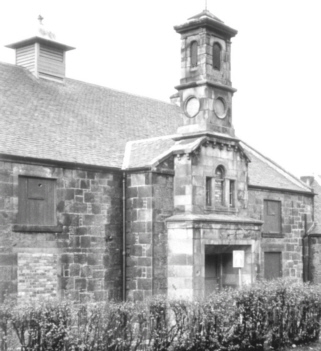
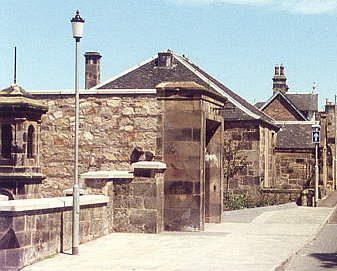
|
The Porte |
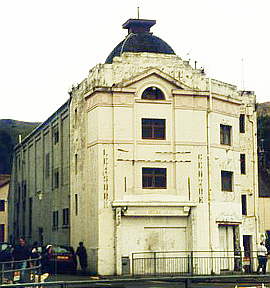 The Porte Cinema had been
built in 1915 by the Burntisland Cinema House Company and was managed
by Mr Tom Lunn. Here too silent pictures were shown and accompanied by
the resident pianist, Mrs Kinnear. Enjoyment of the Cowboys and Indians
with the many serials was enhanced by the inevitable and adjacent sweet
shop (Miss Stocks). Admission prices were 6d, 9d,1/3d, 1/6d (or 2.5p,
3.75p, 6.25p, 7.5p!).
The Porte Cinema had been
built in 1915 by the Burntisland Cinema House Company and was managed
by Mr Tom Lunn. Here too silent pictures were shown and accompanied by
the resident pianist, Mrs Kinnear. Enjoyment of the Cowboys and Indians
with the many serials was enhanced by the inevitable and adjacent sweet
shop (Miss Stocks). Admission prices were 6d, 9d,1/3d, 1/6d (or 2.5p,
3.75p, 6.25p, 7.5p!).
In 1931 Burntisland Associated Pictures Ltd, Falkirk, took over the Burntisland Cinema House Company and on the retirement of Mr Tom Lunn, Miss A.C. Mackie became manageress and a new era began. The installation of the latest sound equipment by the British Thomson Houston Company made the innovation of talking pictures a reality in Burntisland.
The days of Al Jolson had arrived, together with Jeanette McDonald, Nelson Eddy and many other new stars. As the number of cinema goers increased and colour films became reality the Burntisland Associated Picture company looked ahead and visualised a new super deluxe Cinema in the centre of the town. It would be built to the highest standard, together with two shops.
When the new cinema (see below) opened in 1939, the Porte's life as a cinema ended. British Road Services purchased the building in 1955. Pickfords Storage Ltd. took over in the 1960s and made many internal alterations. It was sold to Salvona's in 1970. Later Mr John Cooper acquired the premises and it became an Amusement Arcade, pool and snooker club. In due course, that too closed. [For more recent developments, please see the Porte Cinema page.]
|
The Picture House |
The new era in Cinema going in Burntisland began with the opening of the Palace Cinema Picture Palace on the afternoon of Wednesday the 11th October 1939 - just a year after the Burntisland Town Council had granted a building warrant for a cinema and two shops. The Palace replaced the Porte Cinema.
The new cinema had a seating capacity of 1,040 - 230 seats in the Balcony and 810 seats in the main Auditorium. The entrance into the foyer contained a confectionery and cigarette kiosk, toilet facilities and a central cash desk. Upstairs there was a magnificent lounge decorated with beautiful murals and matching carpet, and management offices.
The Fife Free Press reported the opening on the 14th October 1939:
|
DE-LUXE CINEMA |
In declaring the Cinema open, he praised Mr Wilson ARIBA Architect and all the contractors involved. Mr Wilson then presented Provost Leith with a beautiful tea service as a souvenir of the occasion. Mr Wilson praised all the contractors, for overcoming the difficulties due to the outbreak of war and acknowledged the assistance received from Miss Mackie. He now understood the Directors' great admiration for her Cinema administration.
After the opening, the new Cinema soon became the central point for local people queuing weekly to gain admittance, the prices of admission being 6d and 9d, 1/3d and 1/6d. The first full week's programme was: 'Up the River' starring Preston Foster; 'Racket Busters' starring Humphrey Bogart; 'The Young at Heart' starring Janet Gaynor and Robert Young.
Throughout the years of Cinema going in Burntisland many names come to mind who served the community loyally and faithfully. I offer my apologies for any names omitted:
Commissionaire
- Mr Hugh McDonald; Usherettes - Grace Birrrell, Madge Birrell, Betty
Charles, Ella Charles, Margaret Cunningham, Agnes Ferguson, Doreen
Johnston, 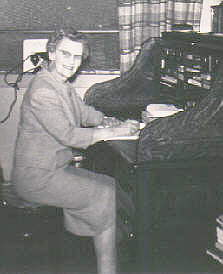 Peggy Le Blond, Pat Thomson,
Agnes Turpie, Mary Turpie, Doreen Wood, Mrs Maplesden, Mrs Thomson,
Jean Farquhar and Jenny Moodie; Cashiers - Miss Taylor, Nellie
Langlands, Norah Cairncross and Miss McIntyre; Projection Staff - Thos
Lumsden, Ivy Wilson, Tom Chalmers, Jack McInnes, Alex Brymer, Andrew
Kidd, Ian Miller and Arthur McGregor; Management - Mr Andrew Maxwell
(Kirkgate cinema), Mr Tom Lunn (Porte cinema), Miss A.C. Mackie
(Manageress); Deputies - J.M. Mackie, N.B. Mackie.
Peggy Le Blond, Pat Thomson,
Agnes Turpie, Mary Turpie, Doreen Wood, Mrs Maplesden, Mrs Thomson,
Jean Farquhar and Jenny Moodie; Cashiers - Miss Taylor, Nellie
Langlands, Norah Cairncross and Miss McIntyre; Projection Staff - Thos
Lumsden, Ivy Wilson, Tom Chalmers, Jack McInnes, Alex Brymer, Andrew
Kidd, Ian Miller and Arthur McGregor; Management - Mr Andrew Maxwell
(Kirkgate cinema), Mr Tom Lunn (Porte cinema), Miss A.C. Mackie
(Manageress); Deputies - J.M. Mackie, N.B. Mackie.
Miss Mackie succeeded Mr Maxwell at the Kirkgate, then proceeded to the Porte Cinema before taking over the Palace, serving the community for over 45 years in Cinema Entertainment. (Miss Mackie is pictured, right, at her desk in the new Palace cinema.)
The advent of television reduced the profitability of a Cinema in a small town. After Miss Mackie's retirement in the early seventies, the cinema ran on for a short time, then closed. The building was gutted by fire on 16th December 1985. Ironic when you recall that the Palace had seating for over 1,000 persons, each seat having an ash tray that a loyal staff checked diligently after the evening performances - the final episode was the work of fire raisers. [For more recent developments, please see the Palace Cinema page.]
My only film memorabilia is Miss Mackie's luncheon menu card, autographed by Laurel and Hardy at a lunch in Edinburgh in July 1947, which I have retained with affection. It has been a great pleasure to remind people past and present of the enjoyment given to the town by Cinema going. In conclusion I would like to convey my sincere thanks to Mr David Ferguson and Mr John Cooper for the information they both provided.
This article is a slightly edited version of a series published in the Burgh Buzz, Burntisland's community newspaper, in 1999. We are grateful to Norman Mackie for permission to reproduce it here.
Webpage by Iain Sommerville;
Help
on bookmarking this page.